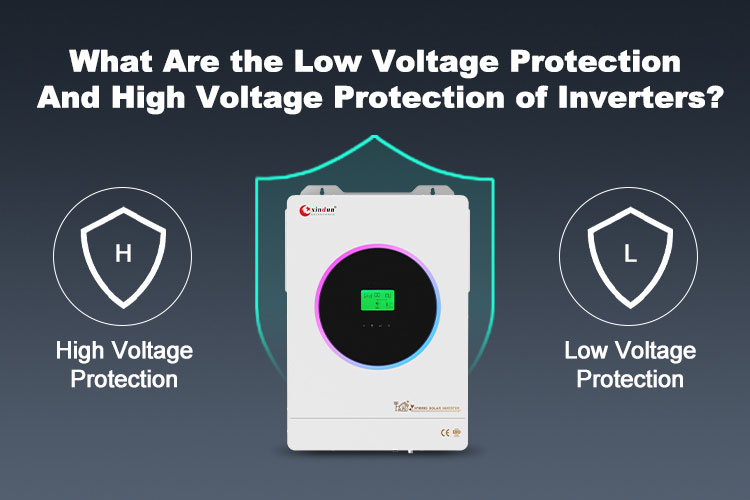
What are the low voltage protection and high voltage protection of off grid inverter? Let Xindun Power make it clear: the object of the above protection setting is the battery, not the mains or the load.

The low voltage protection of the inverter: Generally speaking, the maximum discharge percentage of the battery is 70% of its capacity for lead acid batteries and 80% for lithium batteries; if the battery continues to discharge, it is possible that the battery will be scrapped, no matter what method is used, the battery cannot be charged. Therefore, the inverter sets a low voltage protection to avoid the above situation of the battery and extend the battery life as much as possible.
On Xindun Power's inverter, when the lead acid battery voltage reaches 11vdc/cell, the inverter will start the battery low voltage warning sound and automatically switch to AC power supply; if there is no AC power, the inverter will continue to discharge the battery (during this process, the inverter's battery low voltage warning sound will continue to sound to let the user know), until 10.5vdc/cell, that is, when the lead acid battery has 30% capacity left, the inverter starts low voltage protection, the inverter will automatically shut down and stop battery discharge.
For lithium batteries, when the inverter establishes communication with the lithium battery, all settings will operate according to the BMS settings of the lithium battery.
In addition, Xindun Power's inverter has additional additional functions:
In remote areas, when there is no AC power and only solar energy is used to charge the battery, Xindun Power's inverter has a battery recovery power supply function, that is, even at night, when the battery's dischargeable power is exhausted, the inverter will wait until the daytime light is restored and the battery is charged by solar energy. When the battery reaches 12vdc/cell, the inverter will automatically turn on and repower the load.
If the customer wants to use the battery to power the load first, Xindun Power's inverter will use the mains to charge the battery. When it reaches 13.2vdc/cell, the inverter will automatically switch back to battery power mode, so as to use as little mains as possible.
High voltage protection of the inverter:
The default charging voltage of Xindun Power's inverter is: 14.2vdc/cell. When the battery reaches this voltage value, the inverter will stop charging. Because when the lead acid battery reaches this voltage value, the capacity has reached 100%, and it is fully charged. So why does the inverter sometimes issue a warning of battery high voltage protection? There are many different reasons that can trigger the above protection warning.
Xindun introduces three main reasons:
Firstly: The inverter charging voltage is set too high. When the inverter detects that the battery is fully charged, it continues to charge the battery, then the inverter will trigger its overvoltage protection function: the warning sound will sound. At this time, the user should check whether the charging voltage setting of the inverter is reasonable, and set it reasonably according to the instructions of Xindun Power.
Secondly, the battery itself has reached the end of its service life, and the internal resistance of the battery has increased, making the charging point voltage too high. Xindun puts it another way: the capacity of the battery has actually decreased, but the inverter still charges the battery according to the charging voltage of a new battery. When the battery does not reach the charging voltage set by the inverter, the inverter has been triggered by the battery overvoltage warning sound and stops charging. The specific performance is: the inverter shows that the battery capacity is only about 50-70%, but the inverter is already in standby mode. Common: lithium batteries made of second hand batteries, lead acid batteries or gel batteries that are about to be scrapped.
In this case, the user can use a multimeter to detect the voltage at both ends of the battery. If the battery voltage has reached 14.2vdc/cell when it is not fully charged, it proves that the battery capacity has decreased. It has nothing to do with the inverter.
Finally, MPPT failure. If the charging components of the MPPT are damaged, the battery will continue to be charged and will not stop automatically. This situation is rare, but it is possible.
Battery overvoltage protection is a protection setting that Xindun Power attaches great importance to. Once a lead acid battery is overcharged, the worst case is battery expansion and even acid explosion; lithium batteries will grow lithium dendrites inside, increasing the internal resistance of the lithium battery and shortening the life of the lithium battery.
If you encounter the above problems, please don't panic. Follow the method introduced by Xindun and check step by step. The problem will always be solved. Readers can also find various usage tips of the inverter here at Xindun, so that our off grid inverter can bring you the fun of life.